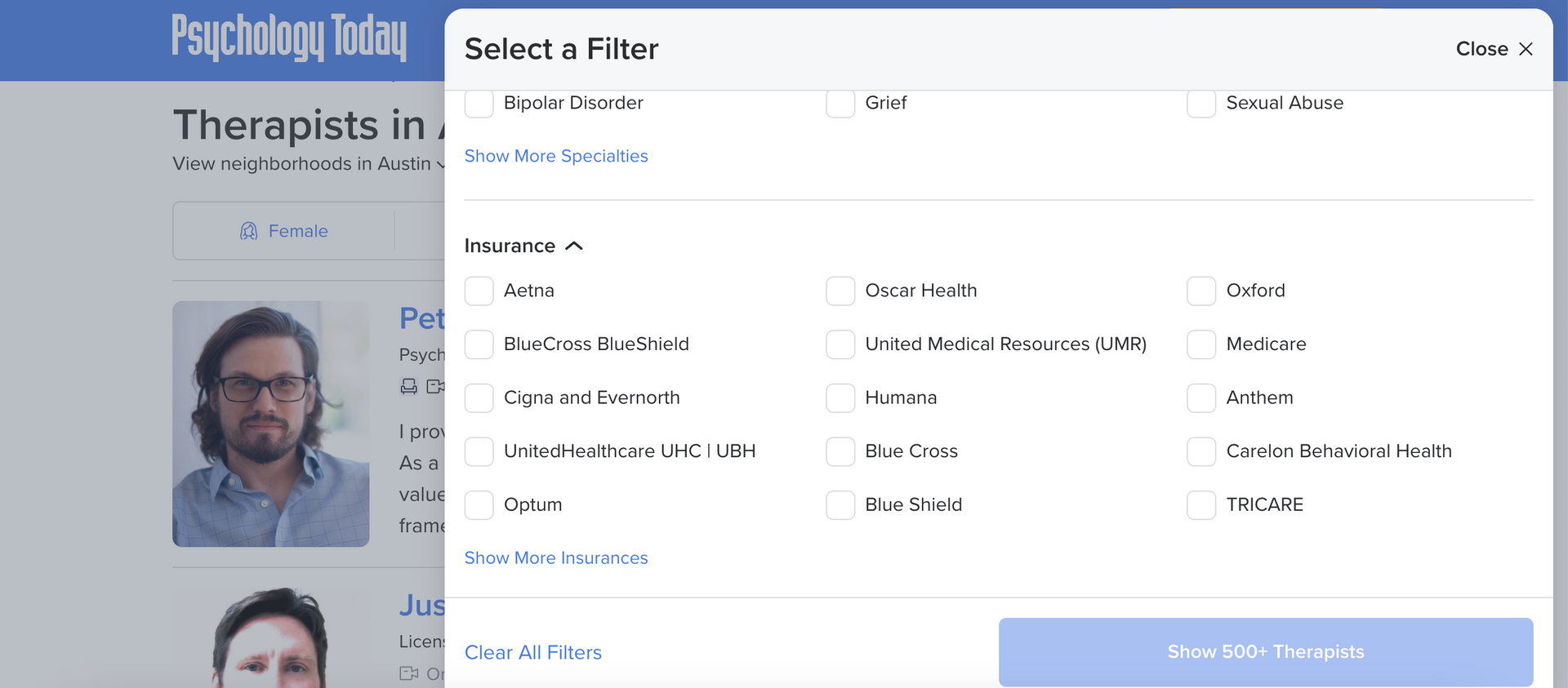How much does Psychology Today cost? Pros and cons
Are you considering using Psychology Today to market your therapy or coaching practice? You’re not alone. For many mental health professionals, holistic therapists, and life coaches, listing on Psychology Today seems like an easy way to gain visibility and attract clients. But is it worth the cost? And will it meet your marketing needs?
In case we haven’t met, I’m Natalia Maganda, a website designer for mental health professionals . I help you amplify your magic, gain visibility, and simplify your marketing efforts through strategic web design and content. If you’re here, you’re probably trying to decide if Psychology Today is the right directory for you—and whether it aligns with your goals.
Let’s dive into the pros, cons, and hidden costs of Psychology Today and how it fits into a broader marketing strategy for your practice.
Before we tackle the costs and benefits of Psychology Today, it’s important to understand what makes any marketing platform effective: connection. A directory profile, no matter how visible, will only work if it resonates with your ideal clients.
Crafting a compelling Psychology Today bio is your secret weapon here. It’s not just about listing your credentials—it’s about connecting emotionally. Psychology Today’s directory gives you a chance to showcase who you are and how you can help, but does it allow you the flexibility to truly stand out? And is it enough on its own?
This brings us to an even more significant question: should you rely solely on a directory, or is it time to create a marketing system that works for you? Let’s explore the key questions around Psychology Today to help you make an informed decision.
How much Is Psychology Today?
Psychology Today costs $29.95 per month to list your profile in their directory and is available in over 20 countries. Make sure to check their website for updated pricing. That works out to around $360 per year. This fee gives you access to their vast network of potential clients, the ability to display your credentials and specialties, and a space to link to your website or contact information.
For many therapists, this cost is manageable compared to the potential return on investment, but it’s important to consider what you’re getting for the price. While the directory boasts high traffic, your profile is still competing with hundreds, if not thousands, of other professionals in your area.

Is Psychology Today free for 6 months?
Psychology Today occasionally offers promotional periods, such as free or discounted subscriptions for new members. This can be a great way to test the platform without committing financially. However, you’ll want to evaluate the performance of your profile during this time.
Questions to ask yourself during the trial period:
- How many inquiries or clients did you gain directly from your profile?
- Did the platform attract your ideal clients, or were inquiries misaligned with your specialties?
Taking advantage of these promotions is a smart move, but make sure you measure the results to decide if it’s worth continuing once the trial ends.
Psychology Today and insurance
One of Psychology Today’s selling points is its integration with insurance filters . Clients can search for providers based on the insurance they accept, which is a major draw for therapy practices that work with insurance plans.
However, this feature has its limitations:
- If you don’t accept insurance, your profile might be overlooked by a large pool of potential clients.
- The platform doesn’t provide advanced tools for explaining how out-of-network benefits work, which could make it harder for some clients to understand their options.
If you do accept insurance, ensure this is prominently displayed on your profile to take full advantage of the feature.

How legit Is Psychology Today?
Psychology Today is one of the most recognizable directories in the mental health space, but does that mean it’s always the right choice? While its legitimacy as a professional platform is unquestionable, it may not be the most effective tool for every practice.
Pros:
- High visibility for mental health services.
- Clients often trust the platform due to its reputation and wide reach.
Cons:
- Profiles can feel generic, making it hard to stand out.
- Heavy competition in populated areas.
- Limited ability to showcase your personality and unique approach.
Psychology Today pros and cons
Pros:
- Affordable at $29.95/month.
- Provides instant credibility due to its established name.
- Offers filters for specialties, insurance, and other client preferences.
Cons:
- High competition within the directory.
- Limited customization for your profile, making it harder to stand out.
- Directory-dependent marketing can feel passive compared to proactive strategies.
Why having a website is crucial as an extra layer of marketing efforts
Sure, listing on Psychology Today is a great starting point—it puts you in front of people actively searching for help. But here’s the thing: it’s just a starting point. If you want to build a sustainable, thriving practice, you need a website. Here’s why your own website is a non-negotiable:
1. Total Control Over Your Brand
Think of your website as your virtual office—it’s the space where you can truly show who you are and what makes your practice unique. Unlike directory profiles, which all look pretty much the same, your website gives you complete freedom to:- Share your story.
- Highlight your values.
- Show potential clients exactly what it’s like to work with you.
A directory listing can make you feel like just another face in the crowd. Your website? That’s where you shine.
2. Attract Clients Through SEO and Lead Generation
Directories like Psychology Today rely on their own SEO to get traffic. But with a well-optimized website, you can attract clients straight to you. Here’s how:- Use keywords (like “anxiety therapist in [your city]”) to get found on Google.
- Create blog posts that answer your ideal clients’ questions and build trust before they even reach out.
- Add lead magnets like free guides or resources to grow your email list and stay connected with potential clients.
With your website working for you 24/7, you’re not just waiting for clients to find you—you’re actively drawing them in.
3. Build Real Relationships with Clients
Your website isn’t just a static profile; it’s a dynamic space where you can nurture connections. You can:- Share helpful content, like blog posts or FAQs, to educate and support potential clients.
- Showcase testimonials and case studies that build trust.
- Create a warm, welcoming vibe that lets clients know they’re in the right place.
When people feel seen and understood, they’re much more likely to reach out—and that’s exactly what your website can do.
4. It’s Your Long-Term Marketing Anchor
Directories like Psychology Today are great, but they’re not yours. Algorithms change, platforms update, and you’re always subject to their rules. Your website, on the other hand, is your online home base. You control:- The content.
- The layout.
- The strategy.
No matter how the marketing world shifts, your website will always be there, ready to grow with you and your business.
Should you use Psychology Today?
Psychology Today can be a valuable part of your marketing strategy, but it works best when combined with a comprehensive approach. A directory listing might attract initial interest, but your website is where potential clients truly get to know you and decide to take the next step.
Having a website doesn’t replace platforms like Psychology Today—it amplifies them.
A directory might help people find you, but your website is what will make them trust you and take that next step. Want to learn how to create a website that’s not just a digital brochure, but a real client magnet? Explore my website design services for therapists .
Related reads:
- How to make $100K as a therapist without seeing 20+ clients a week
- Private practice therapist salary and tips for increasing your income
- The ultimate guide to branding your therapy and private practice
- 40 marketing ideas for therapists
- 10 simple ways to get more therapy clients for your private practice
- How to write an engaging Psychology Today profile
- SimplePractice vs TherapyNotes in-depth comparison
- Therapist networking tips and where to find online events
- Blogging basics and 140 blog post ideas for therapists
- The stress-free guide to social media for therapists

* AI Disclosure: This content may contain sections generated with AI with the purpose of providing you with condensed helpful and relevant content, however all personal opinions are 100% human made as well as the blog post structure, outline and key takeaways.
* Affiliate Disclosure: Some of the links on www.nataliamaganda.com may contain affiliate links meaning that I will get a commission for recommending products at no extra cost to you.

hello! i'm natalia
Latina, web design expert for mental health professionals.
I help ambitious life coaches, therapists and holistic leaders amplify their magic, gain visibility, and simplify their marketing efforts through strategic web design and content.










